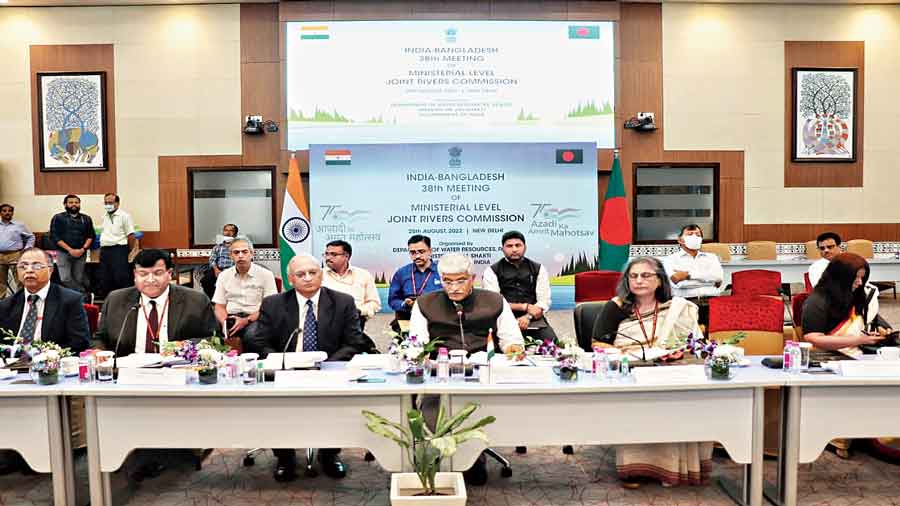An agreement on the sharing of Teesta water between India and Bangladesh continued to elude at a ministeriallevel meeting of the Joint River Commission (JRC) held in New Delhi on Thursday, though official releases from the two countries claimed that all issues related to common rivers had come up for discussions at the session, held after a gap of 12 years.
The official statements — issued from New Delhi and Dhaka — claimed success by citing the finalisation of the text for an MoU for interim sharing of the water of the Kushiyara, which flows into Bangladesh from Assam and an agreement on the design and location of water intake point from the Feni to meet the drinking water requirement of Sabroom, a town in Tripura.
The Indian statement didn’t mention a word on the Teesta while the official statement from the Bangladesh showed Dhaka was getting restless on sealing a water sharing deal, pending since 2011.“Bangladesh side requested for conclusion of the long pending Teesta Water Sharing Treaty at an early date,” said the official release from the ministry of foreign affairs in Dhaka. Although the two countries share 54 rivers, Teesta has been at the centre of all discussions on water sharing since September 2011 when a pause button on the signing of a water sharing agreement was pressed because reservations of Bengal chief minister Mamata Banerjee.
“Any resolution on Teesta water sharing involves the consent of the Bengal government.… As water is a state subject in India, my question is whether the central government consulted the Bengal government before the meeting,” wondered a river expert in Bangladesh.
The Bengal government has maintained Teesta doesn’t have enough water to meet the irrigation needs of both the countries and Bangladeshi, of late, has also started seeing merit in the argument.
“The question is now ensuring that the river doesn’t dry up.… And the two countries have to collaborate for that goal,” said a river expert in Calcutta.
As Bangladeshi Prime Minister Sheikh Hasina is coming to India on a threeday state visit, from September 5 to 7, the issue of Teesta — a politically sensitive subject in Bangladesh ahead of next year's general election — has become a talking point in Dhaka.
That’s why Zaheed Farooque, the minister of state for water resources and A.K.M. Enamul Hoque Shameem, his deputy, elaborated how the ministerial talks — the Indian side was led by Gajendra Singh Shekhawat, Union Minister for Jal Shakti — yielded several positive outcomes.
The Indian establishment — keen to see Hasina in the seat of power in Bangladesh — also tried its best to highlight the achievements made during the ministerial level meeting. “India and Bangladesh share 54 rivers, of which 7 rivers have been identified earlier for developing framework of water sharing agreements on priority. During the meeting, it has been agreed to widen this area of ongoing cooperation by including 8 more rivers for data exchange,” said the release from New Delhi.
India’s decision to extend the period of flood data sharing beyond 15 October to help Bangladesh address unforeseen flood events was also mentioned in the release.
“Any movement is a good news... While Teesta remains the cornerstone of discussions on water sharing as it is the main river in the entire northwestern region of Bangladesh, which is the driest, the attempt to harvest low hanging fruits by signing MoU on sharing of Kushiyara water is indeed welcome,” said a source in Dhaka.
For years, Bangladesh has been demanding a steady share of the Teesta water – the river originates from Sikkim, passes through north Bengal and enters Bangladesh – for irrigation in the districts of Nilfamari, Rangpur and Dinajpur. Time and again, it has been mentioned that if the flow of water remains steady on lean months – from December to April – it would help in irrigating around 79,000 hectares of agricultural land in these areas.Around 47 years back, the then Bengal government had taken up the Teesta barrage project, the largest irrigation project of north Bengal, to provide water in 9.22 lakh hectares of land in six districts of the region.
However, the project remained unfinished due to a number of reasons, and till now, water from the river is provided for irrigation to hardly one lakh hectares of land. The Centre has announced it as a national project in 2009 but there hasn’t been much development in these years. Soumen Nag, a social researcher in Siliguri, mentioned that in the past five decades, there has been a change in the use of land in many areas where water from Teesta was supposed to be provided for irrigation.
“The project needs to be redrawn. Due to rapid urbanisation and population growth, stretches of agricultural land in many adjoining areas of Siliguri are being used for residential or commercial purposes now,” he said.










